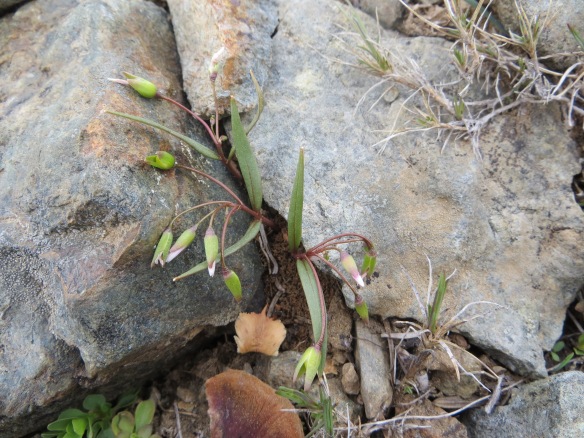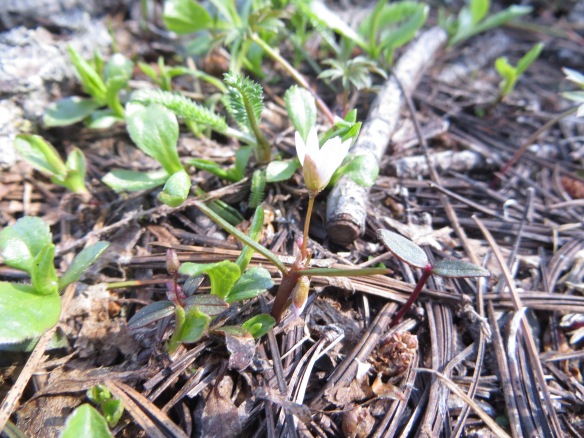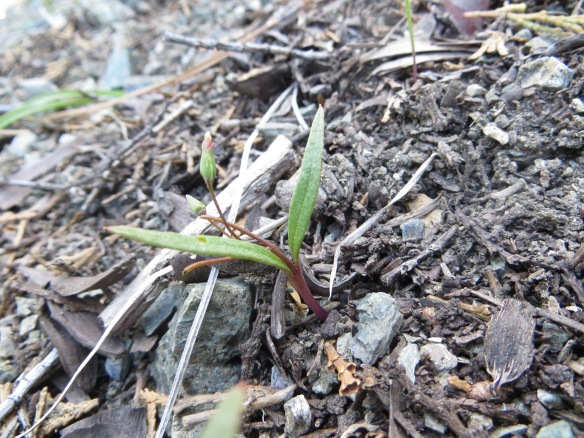 Above, two members of the genus Claytonia from different Sections — C. “serpenticola” (an undescribed species in Section Claytonia) on the left, and C. rubra (Section Limnia) on the right. The two occur in close sympatry in the Lassic Mountain Wilderness, practically high-fiving their cauline leaves. This was a highly productive trip to the north, but before I get to that…
Above, two members of the genus Claytonia from different Sections — C. “serpenticola” (an undescribed species in Section Claytonia) on the left, and C. rubra (Section Limnia) on the right. The two occur in close sympatry in the Lassic Mountain Wilderness, practically high-fiving their cauline leaves. This was a highly productive trip to the north, but before I get to that…
I want to say THANKS to all who supported my recent fundraising endeavor with Dr. Ingrid Jordon-Thaden on Experiment.com — we are going to be able to do some much needed fieldwork and conduct fundamental biodiversity research with the money you have all helped us to raise! Thanks so very much, and stay tuned for updates (Lab Notes and Blog Posts) on this ‘open access’ alpine research.
OK, back to talking about my recent trip to Oregon and California — I was on the hunt to find locations where multiple Claytonia occur in close sympatry, particularly areas where species may be hybridizing. I am interested in knowing just how well species can maintain their identities in these situations…
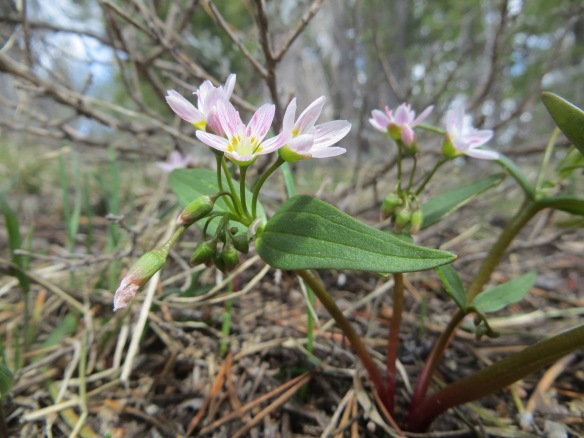 I started the trip by meeting up with Larry Crawford for some botanizing in the Sierra Nevada — we found Claytonia sessilifolia (Torrey) Henshaw(pictured above) flowering profusely near Carson Pass in an area that Larry had previously scouted. This plant was featured in the recent Spring Beauty Pageant hosted on my website — it isn’t too late for you to cast a vote for your favorite(s)! In this population it seems like there is only one species present (C. sessilifolia), but this taxon occurs in an interesting habitat (pictured below, with Diana Jolles and Larry Crawford). It also occurs next to some other fantastic spring ephemerals, such as Dicentra uniflora (pictured below) — the hike was well worth it!
I started the trip by meeting up with Larry Crawford for some botanizing in the Sierra Nevada — we found Claytonia sessilifolia (Torrey) Henshaw(pictured above) flowering profusely near Carson Pass in an area that Larry had previously scouted. This plant was featured in the recent Spring Beauty Pageant hosted on my website — it isn’t too late for you to cast a vote for your favorite(s)! In this population it seems like there is only one species present (C. sessilifolia), but this taxon occurs in an interesting habitat (pictured below, with Diana Jolles and Larry Crawford). It also occurs next to some other fantastic spring ephemerals, such as Dicentra uniflora (pictured below) — the hike was well worth it!
Following some rest and recovery at Larry’s house (thanks, Larry and Suzanne!), my colleagues and I continued north to Lassen Volcanic National Park, catching a wonderful view of Mt. Lassen (pictured below) — this was my first time taking in such a beautiful sight. I also have never (knowingly) been this close to a stratovolcano. I can’t say that I was nervous that the mountain might erupt, but it actually hasn’t been long since something like that happened (click here to read more about the geologically recent eruption of Lassen Peak). Unfortunately we didn’t find any Claytonia in this area, but we might have also been a tad on the early side for the area we looked — several feet of snow in some drifts. It has been a bit of a whacky weather year…
 Having been thwarted by a lack of Claytonia at Lassen Volcanic National Park and lower elevation sites in Lassen National Forest, I decided to book it northward to Crater Lake National Park in an attempt to catch up with a rapidly fading spring. Many of the areas in California where Claytonia have previously been reported as abundant are looking quite parched — the Spring Beauties are apparently less than pleased about it. At Crater Lake, though, we found C. sessilifolia plants blooming where else but in the parking lot (pictured below)!Snagging a few quick pictures of the cinder cone “Wizard Island” (pictured below) in the middle of Crater Lake was just a bonus of doing fieldwork in the area. 😉
Having been thwarted by a lack of Claytonia at Lassen Volcanic National Park and lower elevation sites in Lassen National Forest, I decided to book it northward to Crater Lake National Park in an attempt to catch up with a rapidly fading spring. Many of the areas in California where Claytonia have previously been reported as abundant are looking quite parched — the Spring Beauties are apparently less than pleased about it. At Crater Lake, though, we found C. sessilifolia plants blooming where else but in the parking lot (pictured below)!Snagging a few quick pictures of the cinder cone “Wizard Island” (pictured below) in the middle of Crater Lake was just a bonus of doing fieldwork in the area. 😉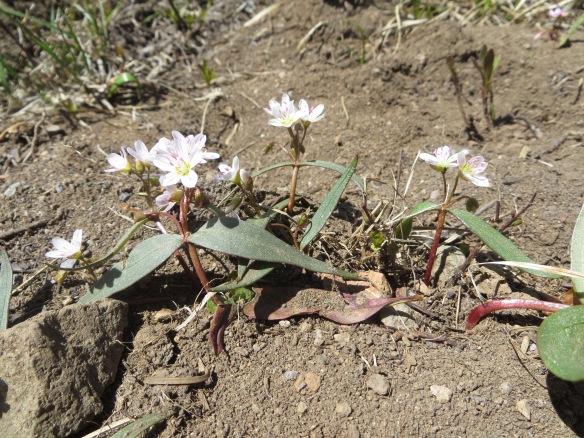
We found some more plants a few miles north of Crater Lake NP on the Rogue River-Siskiyou National Forest, and I also happened to snap a quick picture of the BEAUTIFUL Mt. Thielsen (pictured below) on my way out of Crater Lake National Park — this is another place I’ve got my eye on visiting. I’ve heard the Claytonia on Mt. Thielsen are quite interesting… 
Next was Abbott Butte (west of Crater Lake National Park) — I ABSOLUTELY had to visit that area this year, as it is the type locality for Claytonia obovata Rydberg. Ray Davis chose to sink this taxon into synonymy in the 1960’s — it has been treated as C. lanceolata since that time. Ray mentioned in his 1966 North American Perennial Species of Claytonia that he collected plants answering the original descriptions of C. obovata, C. multicaulis, and C. chrysantha, as well as C. lanceolata at Abbott Butte. Although he didn’t recognize C. obovata, tubers he collected of that taxon from around the type locality that he grew in a ‘common garden’ retained their rounded leaf shape. What did I find at Abbott Butte? Claytonia lanceolata (pictured below, lacking bifid petals), but not any C. obovata — did it not come up this year? I’ve certainly observed this happening before with C. “peirsonii” in southern California… at least Julian (pictured below) found some delicous black morels (Morchella elata-M. angusticeps-M. conica complex). = YUMMY.
What do you do when you can’t find a species at its type locality? You write a paper about it — look for Stoughton et al. (in prep.) coming to a Madroño near you. Fortunately, I have seen C. obovata previously with Heath Bartosh at Hull Mountain — this area is also mentioned in the protologue for C. obovata Rydberg. I did find C. obovata with Diana Jolles and Julian Roberts later during our trip near Cory Peak and Mount Eddy on the Shasta-Trinity National Forest in the Klamath Region of California, but I want to tell you first about the next stop on our road trip at the Siskiyou Mountains of southern Oregon — Observation Peak (pictured below) is an area where C. “serpenticola” (pictured below, and at the beginning of this post) is known to occur.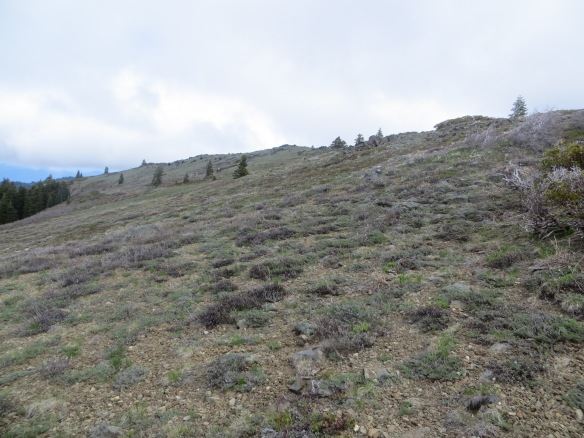
After seeing C. “serpenticola” (pictured above) more or less ‘alone’ in the Siskiyou Mountains of southern Oregon on serpentinite and peridotite, we next saw C. obovata (pictured below) similarly secluded in the Scott Mountains of California near Cory Peak — I now had my search images for a hike that was a major part of the trip. The two species occur in sympatry at Deadfall Lakes just below Mount Eddy, which is where we were headed next. I REALLY want to measure levels of hybridization in this population on Mount Eddy — obvious intermediates exist in the area in seemingly marginal habitats.
What do hybrids between C. obovata and C. “serpenticola” look like? They probably look something like the pictures below — the two species occur in very close proximity in this area…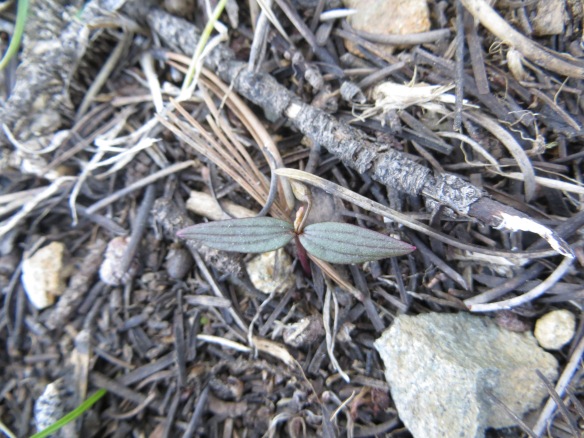
SUCH A COOL SPOT — I will revisit this area next year when there is hopefully a bit better snow pack (which generally = many happy Claytonia). Who is coming with me?! I’m climbing up to the top again for sure. Claytonia “serpenticola” (pictured below) grows very near to the summit, and the view of Mount Shasta (pictured below) from atop Mount Eddy is SPECTACULAR.
After poking around Mount Eddy with Dana York and Julie Nelson, and a much needed night of rest (Thanks, Dana and Eva!), Diana and Julian headed with me south to the Lassic Mountain Wilderness (Six Rivers National Forest) and Anthony Peak (Mendocino National Forest) to see C. “serpenticola” (pictured below) and C. obovata (pictured below) at additional areas where they occur in allopatry — plants were pretty crispy in northern California, but they were still identifiable!
I am VERY excited to see how things shake out in the molecular phylogeny I am developing for this group… Stay Tuned!!!





